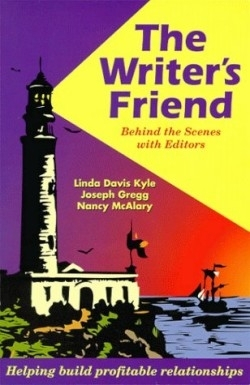The Writer's Friend
Behind the Scenes with Editors
What would increase the chances to become a successful writer? Perhaps a friend who knows what editors want? Kyle, Gregg and McAlary have prepared a behind the scenes guide to the publishing business. All three are successful writers and have teamed up to be that friend to writers. They reveal their strategies that have brought them success in a tone that’s empathetic to the dream yet serious about the business tactics.
Presented are tips about how to address editors, using “pegging” (categorizing) an article for an editor to enhance the chances of a sale, the value of writing in one’s “head” prior to putting words to paper and the typical path of a submitted work. Also discussed in this book are researching one’s audience, writing query letters, the ins and outs of interviewing and improving one’s style. They stress the importance of remembering small details-like sending IRCs (international reply coupons) along with the SAE (self-addressed envelope), if the international editor requires a return envelope, rathing than affixing a domestic stamp that could not be used abroad.
While much of the book’s content is familiar there are several aspects that make it worthwhile for the novice seeking to start or expand their portfolio. “It doesn’t matter how good the writing is if it doesn’t fit the audience,” stresses Tim Horan of The Greyhound Review at the end of a chapter on attracting an editor’s attention. Such quotes and advice from editors and writers from publications as well known as Cosmopolitan to lesser known ones such as San Francisco Peninsula Parent are placed throughout.
There’s also an interesting section using fictionalized editor Barry Wesson, which takes readers into a typical day in the life of an editor based on real life experience. Here, the emphasis reminds writers that an editor does more than sit waiting for an unknown freelancer’s manuscript; that they, too, have a life beyond their job-with all the common pressures. The more a writer can be cognizant of this and follow the rules accordingly, the more likely they’ll find success. Another feature that makes this book attractive is that the editors and writers do not dwell any more than necessary on the points they present, moving swiftly from one topic to another. This makes it as easy to read the first time as it is to stride back through to refresh one’s memory on advice like Scott Edelman’s, from Sci-Fi Entertainment, who offers at the end of a chapter on cooperating with editors: “(Writers) should take rejection in a professional manner, knowing that they’re in it for the long haul, and even though I pass them up now I might have a need for them later. They should worry more about planting the seed for a career than investing all their hopes and energies on a single story.”
Reviewed by
Patricia Voice
Disclosure: This article is not an endorsement, but a review. The publisher of this book provided free copies of the book to have their book reviewed by a professional reviewer. No fee was paid by the publisher for this review. Foreword Reviews only recommends books that we love. Foreword Magazine, Inc. is disclosing this in accordance with the Federal Trade Commission’s 16 CFR, Part 255.

